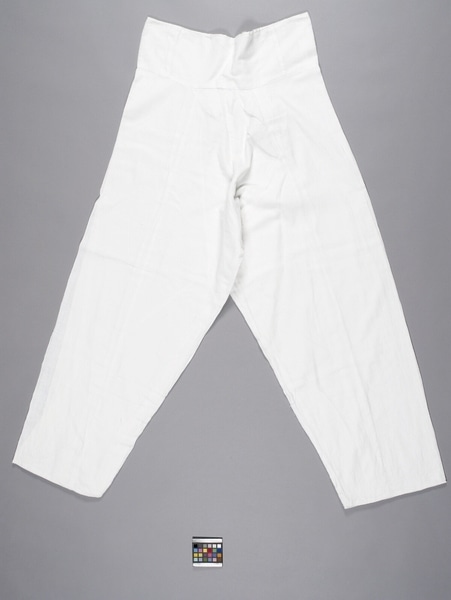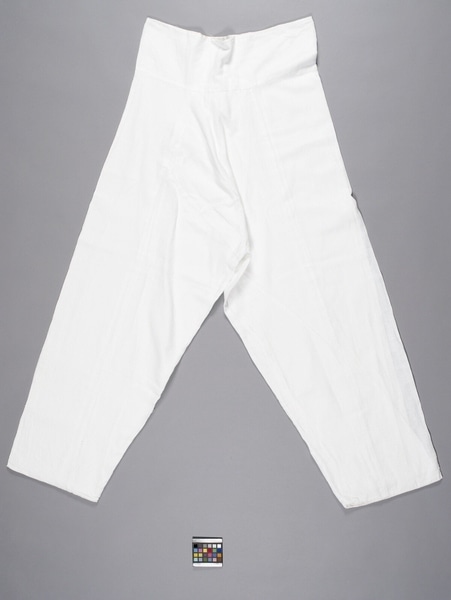Pants Item Number: 2535/1 from the MOA: University of British Columbia


Description
Trousers made of white cotton gauze lined with white cotton. The trousers have a wide, straight waistband from which the legs angle out in a wide V. There is a continuous seam on the inner edge of the legs and rounded crotch and second seams, front and back, about one third of the width away from the centre seam. An additional seam, front and back, angles from about four centimeters away from the centre of the crotch to one of the leg seams. There is an additional seam from the crotch to the waistband on both sides. Both outer shell and lining are constructed the same way, and are joined with invisible seams. Pants were to be worn with jacket and coat (2535/2-3).
History Of Use
Type of clothing formerly worn by rural people. Clothing of good quality white cotton was worn by rural intellectuals, such as teachers, in the 1950s. Good quality cotton and rayon were very precious in the early 1950s in the countryside. In the immediate postwar period ordinary rural people wore clothing made of blanket fabric, or clothing left from the army or obtained from UNICEF. Later those who remained poor wore odd jackets and pants obtained through relief programmes, while those who were more prosperous wore white clothing except for festivals, when coloured clothing was worn. Older men wore long coats “Tu-ru-ma-gi” and horsehair hats. In the winter people wore padded clothing. When rural women worked in the rice paddies, they pulled their skirts up between their legs so they became like pants. Rural people wore very clean clothes on social occasions. Women washed the clothing in cold mountain streams, and ironed it by beating it against a stone platform with wooden beaters, two women sitting facing each other.
“Ba-ji” constructed in this way, with the narrow top band, were characteristic of this time. Otherwise they had changed little for many years. Centre seams were unusual, and may reflect western influence or scarcity of fabric.
In the cities, men began wearing western suits during this period, and urban women wore Korean “Jo-go-ri” and “Chi’ma” in finer materials and bright colours, although by 1958 they, too, began to wear western clothing.
Narrative
Mr. Waddell did not actually wear this set of clothing. He also had padded socks and rubber Korean-style shoes to complete the outfit.
Specific Techniques
Some seams are machine-sewn while others are hand-sewn. All are concealed between the two layers of the pants. The pants were sewn inside-out and then reversed through a small opening, which was then sewn shut.
Item History
- Made in Korea between 1955 and 1958
- Collected between 1955 and 1958
- Owned by Joan Waddell before August 18, 2001
- Received from Joan Waddell (Donor) on August 18, 2001
What
Who
- Culture
- Korean
- Previous Owner
- Joan Waddell
- Received from
- Joan Waddell (Donor)
Where
- Holding Institution
- MOA: University of British Columbia
- Made in
- Korea
When
- Creation Date
- between 1955 and 1958
- Collection Date
- between 1955 and 1958
- Ownership Date
- before August 18, 2001
- Acquisition Date
- on August 18, 2001
Other
- Item Classes
- textiles
- Condition
- good
- Accession Number
- 2535/0001